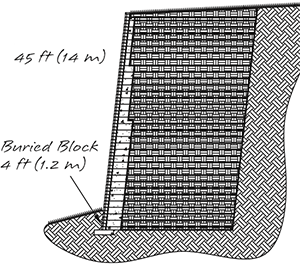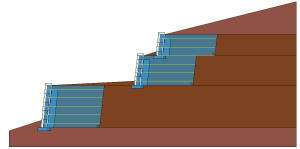
|
ABU Online
Our Design Professional ABU Online events were created to help you with your retaining wall needs. Our local production and sales partners will be happy to schedule in person training on any topics you see below (call us if you are looking for those individuals), but feel free to use these to help with immediate needs.

|
Design Professionals
Upcoming Events:
Allan Block 3D Modeling Tool
AB 3D Modeling Tool - What is it and How does it Work with AB Walls Design Software?
Fridays @ 1:30 CST: (30 min)
Sign up:
Click Here to Choose a Day
Best Practices: Chapter 12, Above Wall Considerations
September 26, 2019
Sign up:10 AM CST
Sign up:2 PM CST
Sign up:4 PM CST
AB Walls Design Software Tutorial
October 24, 2019
Sign up:10 AM CST
Sign up:2 PM CST
Sign up:4 PM CST
AB Walls Design Software Advanced Tutorial Part 1
November 20, 2019
Sign up:10 AM CST
Sign up:2 PM CST
Sign up:4 PM CST
AB Walls Design Software Advanced Tutorial Part 2
December 18, 2019
Sign up:10 AM CST
Sign up:2 PM CST
Sign up:4 PM CST
|

A NOTE ABOUT CALENDAR REMINDERS: Once registered for an ABU Online event, you will receive an email notification with a calendar invite attached. Simply open that calendar invite and save it to your calendar for easy access in the future. In addition, you should receive 2-3 email reminders about the event.
|
Inspiring Project Ideas





|
|
Bottomley Creek Flood Protection
Back to Top
|
Along the Red River, north of Winnipeg, Manitoba Canada, lies the rural municipality of East St. Paul. Branching out from the waterway is Bottomley Creek, a stream that turns disastrous when the river embarks in its infamous tendency to flood. An ultimate decision came to finally stop the relentless disruption to the community.
Stantec Engineering was contacted for project insights on how to move this plan forward. Going through multiple design options—and not wanting to disrupt the surrounding natural environment—it was concluded that a dike was the most efficient manner of implementing flood prevention. Lee Hotas of Expocrete, Allan Block’s local manufacturer, discussed using Allan Block in lieu of the original suggestion of using steel sheet piles. Not only would this avoid removing all existing trees, but would also be much more cost effective. Hotas even mentioned that “in Winnipeg, Allan Block is known as flood protection block.”
Once homeowner approval was confirmed for block color and construction access was granted, Stantec set to work on a design. Not only did the dike need to do its job, but it also needed to be visually pleasing.
.jpg)
|
With how tight the space was between the houses and the creek; the installation required some special considerations. The back-to-back configuration needed a clay core to prevent water movement through the wall, which had to be placed concurrently with the walls. General contractor Borland Construction entrusted certified Allan Block wall installer JD Penner Ltd. to build the dike. In relation to the close proximity to the homes, the choice of a terraced wall was selected as a more desirable aesthetic. Allan Block’s “flexible construction and stable configuration” made it a simple implementation.
According to Ben Green, project manager of JD Penner, “Allan Block was the perfect style of block for this wall, because of its versatility for stairs and terraces that aren’t available in other options.” Indeed, functionality and ingenuity are key with fulfilling any site requirements; not to mention homeowner’s appeal.
Check out the case study for the full details on the Bottomley Creek Dike Project.
|
|
|
|
Wall Embedment
Back to Top
Bury extra block to avoid burying your reputation.
|
|
When designing a segmental retaining wall (SRW), the top of wall and final grade elevations are often very clear on the site plans. One thing that isn’t always so clear, is how much embedded block to bury for your wall. While the buried block does not add to the aesthetics of the wall, it certainly adds to the function of the system. Buried block gives stability at the base of the wall, and in certain situations can be the difference between a wall failing within the first year, and the wall standing strong after 30 years.
|
|
According to our Best Practices for SRW Design, the minimum amount of block that should be buried for any SRW is 6 in. (150 mm) for walls that are 6 ft. (1.8 m) and under, or 1 in. (25 mm) for every 1 ft. (0.3 m) of wall height for walls that are over 6 ft. (1.8 m). While these numbers are important, it’s important to remember that they are minimum values for embedment. Certain site parameters may require that more block be buried than the minimums. Some examples of site parameters that would lead to increased buried block include having a slope below the wall, having a sidewalk that will be installed near the bottom of the wall, or if there will be water present near the base of the wall.

|
For example, if you know that there will be future excavation below your wall to install a driveway, it is important to know that excavation for that driveway could very well undermine the bottom of your wall. In these situations, our Best Practices document says to bury extra block to avoid undermining caused by any future excavations.
Another situation that often requires more block to be buried is scouring. Scouring is very similar to erosion in that earth around your structure can get moved around. One of the main causes of scouring is water currents or waves moving the dirt at the foot of the retaining wall. This can be a big issue because if the earth at the foot of the wall gets washed out, it is as if there was no buried block at all. In order to solve this, the engineer can analyze the scour requirements and determine the additional number of buried courses needed. Or, they may call for adding rip-rap or articulating concrete mats to minimized the scour potential.
As a general rule of thumb, if there is any chance that the bottom of the wall could get washed away or excavated then it is important to bury extra block.
For more information visit allanblock.com and check out our Best Practices document or our installation guides for building walls into slopes. Another great resource would be to review our past technical newsletter on burying extra block. For any additional questions, contact us at engineering@allanblock.com
|
|
|
|
AB Walls - LEM (Limit Equilibrium Method) Coming Soon!
Back to Top
|
|
In our 4th Quarter of 2017 Technical Newsletter we introduced Limit Equilibrium Method (LEM) by dedicating the entire newsletter to the concept of the “Baseline” solution. Since then, a lot has happened with LEM. The Federal Highways Administration (FHWA) adopted LEM as a viable design method for segmental retaining walls (SRW’s). AASHTO followed suit very recently with the announcement that they will be included it in their 2020 Bridge Design Manual, and the National Concrete Masonry Association (NCMA) is currently working on the final drafts of a new LEM chapter to be included in their SRW Design Manual.
Not to be outdone, since LEM has been in the Allan Block Engineering Manual for nearly two years now, we are working on adding the LEM Baseline solution to AB Walls 3D. Our software will provide a final design output for not only simple single wall designs, but also the ability to design complex terraced structures. Never before has a segmental retaining wall design program been able to design terraced structures.

Users familiar with AB Walls 3D will be able to use the program as usual with elevation, plan views and multiple section designs. Additionally, they will be able to include panels that are terraces. They likewise can modify the infill and retained soils for each terrace, add surcharges between terraces and be able to export their complex terrace structures to DXF and to ReSSA like they currently can. As a reminder, the DXF file is a file that can be read by CAD programs such as AutoCAD and ReSSA, a global stability modeling program.
Our goal is to have AB Walls available by the end of this calendar year and will start providing personal tutorials to the engineering community soon after its release.
For more information on LEM please see our Engineering Manual, our 2017 Technical Newsletteror contact us directly at engineering@allanblock.com.
|
|
|
|
Did We Miss Someone? If you know someone at your company who doesn't want to miss out on this amazing newsletter, send them this email so they can sign-up for the AB Technical Newsletter here!
|
|